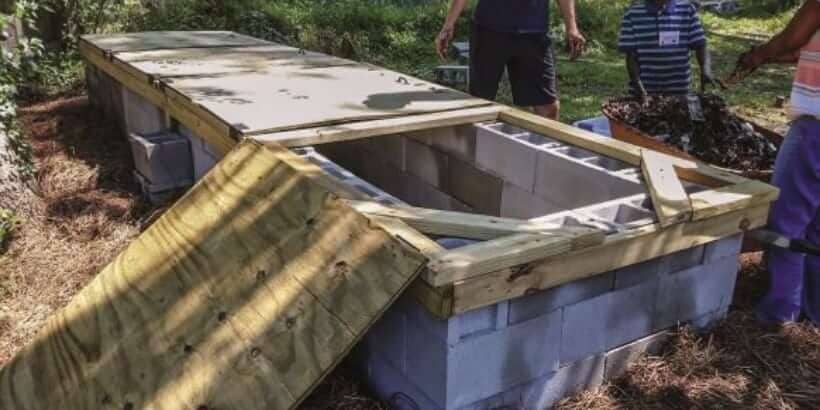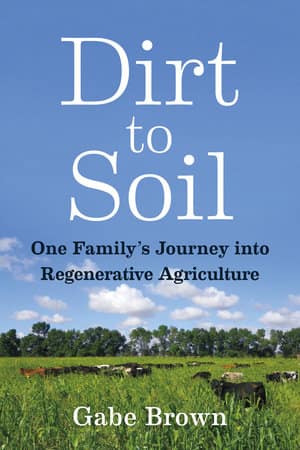Vermicast Structures: Worm Real Estate

Farmers rely on earthworms to create vermicomposting systems and where the worms live and grow are the most essential part of the operation. The addition of vermicast improves seed germination, enhanced seedling growth and increased plant productivity. So if you’re ready to get into vermicast and start growing earthworms, keep reading!
The following is an excerpt from The Worm Farmer’s Handbook by Rhonda Sherman. It has been adapted for the web.
Types of Vermi-Systems
Let’s take a look at the major types of vermi-systems that worm farmers are using to grow earthworms and produce vermicast. I start with the simplest—a windrow—and then cover pits, bins, and continuous flow-through bins.
Windrows
Windrows are linear piles containing bedding and feedstocks that will eventually reach heights of 24 to 30 inches (61–76 cm). They are typically 4 to 8 feet (1.2–2.4 m) wide and however long the space allows. Many people living in milder climates, such as the West Coast of the United States, have established outdoor windrows for vermicast production, though windrows can also be set up inside large buildings.

This shade house at Arizona Worm Farm houses a dozen wedge-style vermicomposting windrows. Photograph courtesy of Zachary Brooks.
A front-end loader, skid steer, shovel, or pitchfork can be used to make a windrow. Simply spread a 6- to 8-inch-deep (15–20 cm) layer of bedding of the desired width and length on bare ground and add 1 pound (0.5 kg) of Eisenia fetida earthworms per square foot (0.09 m2) of surface area. It’s important to smother vegetation first so grass and weeds don’t grow into the windrow, which would interfere with harvest. Since composting earthworms do not burrow, you don’t have to worry about them migrating out of the windrow into the soil. After the worms have settled into the bedding, apply feedstock in a layer 1 to 11⁄2 inches (2.5–3.8 cm) deep, and wait until the feed has been consumed before adding more. During cold weather, 3 to 4 inches (7.6–10.2 cm) of feedstock may be applied to the top of the windrow to help keep the worms warm. Although many worm growers have success with outdoor windrows, some folks report problems with excess moisture, anaerobic areas, and predators such as moles and birds. Vermicomposting in windrows is a slow process that can take up to 12 months to produce finished vermicast.
Pits or Trenches
Pits, or trenches, have been used for decades. As with other vermicomposting systems, you lay down moist bedding, add worms, and apply thin layers of the feedstock on top. People like pits for vermicomposting because they are simple holes in the ground—no construction required. The earthen sides provide insulation against both hot and cold weather. Some people choose to line their pits with cement blocks. However, raising earthworms in pits can strain your back from bending over so often. Another disadvantage is that pits can be flooded by heavy rains.

Earthworms consume hog manure in the dark-colored trenches inside this shelter at a hog farm in North Carolina.
A successful trench model was established in North Carolina in the early 2000s. A hog manure vermicomposter named Tom Christenberry was having trouble with his continuous flow-through bins overheating, so he created a trench system that allowed the ground to help moderate excessively cold or hot temperatures. Inside a pole barn he dug five trenches 4 feet wide by 200 feet long by 21 inches deep (1.2 × 61.0 × 0.5 m). Between the trenches were hardpacked dirt and gravel lanes that would support a tractor. To feed the worms, he drove a tractor straddling the top of a trench. The tractor pulled a manure spreader that was calibrated to deposit hog manure into the trench, and a worker would then use a rake to evenly spread the manure 1 inch (2.5 cm) deep across it. He carried out this feeding process weekly using raw hog manure that had been flushed out of a barn and run through a solids separator.
Before you commit to setting up a pit system, ask yourself whether you will be able to handle all of the bending that it will require to apply feedstock, check the worms and bed conditions, and harvest the vermicast. I used to think I could work with pit systems, but I now realize that I couldn’t deal with getting on my knees, bending over, and reaching down into the pit on a regular basis.
Bins
Worm bins are a type of containment system that can be built, purchased, or repurposed. They are set up like the previous systems described—with moist bedding on the bottom, worms added on top, and then feedstock applied in thin layers on top of the bedding.

Concrete block worm-bin at a farm in the Dominican Republic .
To make worm bins, worm growers often repurpose discarded items, including refrigerators, livestock tanks, tubs, barrels, wooden or plastic boxes, mortar trays, plastic buckets, washing machine tubs, and other containers. If such containers have solid bottoms or sides, drill holes for drainage and airflow.
Earthworm beds and bins can be built by hand from a variety of materials, such as lumber, plywood, concrete or cinder blocks, fiberglass, structural clay tile, poured concrete, or bricks. Wood is one of the most popular materials, but raw wood may decompose within 4 to 10 years, depending on the climate and other factors, so many folks will cover it with plastic or coat it with raw linseed oil. Avoid using redwood, cedar, or other aromatic woods to construct the bins; they contain tannic acid and resinous saps that are damaging to earthworms.
Worm farmers throughout the world build concrete-block bins, often on bare ground. They are inexpensive, easy to obtain, and won’t rot. Concrete also provides more insulation than plywood, so it will keep your worm bed warmer in the winter and cooler in the summer.
Remember that birds love to eat worms, so if your bins aren’t lidded you should use netting to keep out avian predators. Always keep direct sunlight off the worms, too, by either locating the bins in a well-shaded area, placing them under a roof, or covering them with lids.

These MacroBins for vermicomposting at a composting facility in San Diego are the same type I use at my worm barn in North Carolina.
The worms in my Worm Barn at the Compost Learning Lab live in two MacroBins. These containers are manufactured by a company called Macro Plastics to store and transport vegetables. When I first saw one, I immediately thought, This would make a good worm bin! and decided I had to acquire some. The MacroBin is constructed of impact-grade copolymers and has smooth surfaces and ventilation slots on every side, as well as the bottom. It is approximately 45 inches long, 48 inches wide, and 34 inches high on the outside (1.1 × 1.2 × 0.9 m). The inside of the bin is approximately 41 inches by 45 inches by 29 inches (1.0 × 1.1 × 0.7 m). It can accommodate 1,300 pounds (590 kg) of materials and can be lifted by a forklift from any side. The MacroBin costs about $230, with discounted rates for bulk purchases. I wasn’t aware of anyone else using these agricultural bulk containers as worm bins until I saw 10 of them set up for vermicomposting while touring a composting site in San Diego!
Garry Lipscomb and Bill Corey, the owners of NewSoil Vermiculture LLC in Durham, North Carolina, made bins out of plastic 55-gallon (210 L) drums for the commercial operation in the basement of their home.
Many worm farmers repurpose plastic IBC totes (intermediate bulk containers) to make worm bins. They are large tanks used to store and transport 275 to 330 gallons (1,040–1,250 L) of liquid or bulk materials. IBC totes cost less than $150 new, with versions housed within metal cages available for approximately $100 more. These tanks are being repurposed for a variety of uses, so it’s pretty easy to acquire them used at a lower price.
Recommended Reads
Recent Articles
Aside from the sheer pleasure of telling your friends, straight-faced, that you maintain your garden using something called a “chicken tractor,” there are a slew of other benefits to working the land with a few of your animal friends. Getting rid of pests without chemicals, for one; letting them do the work of weeding and…
Read MoreIf the idea of running a vegetable farm sounds daunting, you’re not alone. What can you do to simplify techniques and reduce expenses? Where do you even begin?
Read MoreWhen you’re walking around the grocery store looking at the vegetables, it’s probably hard to imagine that a century ago there was twice the amount of options.
Read MoreIf you love tomatoes, you probably already know just how many varieties of these summertime staples there are. But do you know what makes each one unique?
Read MoreAdding the long game of trees to your system results in a deeper and more reliable, resilient and profound presence to your annual vegetable production.
Read More








